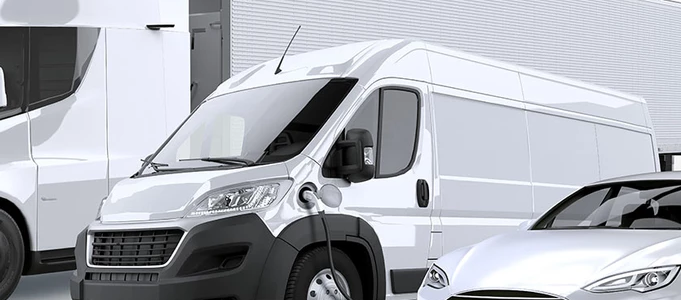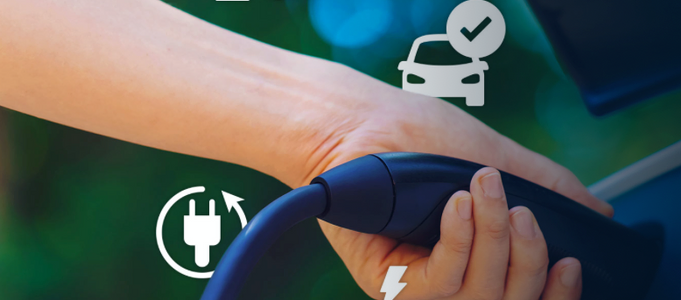Tracking Providers with Diversified Hardware for Versatile Solutions
Installing cellular assisted GPS devices in road vehicles and heavy machinery has become a standardized process for different fleet tracking platforms. While this approach provides a cost effective and powerful tracking solution for fleets able to maintain consistently solid cellular network connectivity, it’s not applicable in case uses taking place indoors or outside a cellular network. A more diversified set of hardware that utilizes Bluetooth technology in tandem with cellular assisted GPS is required to track assets in these environments.
It’s easy to take for granted the incredible energy density that gasoline-fueled vehicles provide to power conventional GPS tracking devices, but tracking smaller assets that aren’t able to power a GPS device has been historically challenging because of the limitations of battery technology. Fortunately, product developers in recent years have been able to take advantage of improved battery technology as well as Bluetooth sensors to offer tracking solutions for assets that were impractical to track in the past.
Case Uses for Specialized Asset Tracking
Modern specialized asset tracking devices work by using long lasting batteries to track devices anywhere out in the field with cellular assisted GPS tracking and leveraging Bluetooth sensors to let users know where assets are at a fixed location: warehouse, works yard, etc.
This robust new tracking methodology is utilized by a variety of industries with case uses such as:
Tracking forklifts that operate in indoor and outdoor environments. Usually unachievable with traditional cellular assisted GPS due to a signal loss once the forklift is indoors. By installing Bluetooth readers throughout the operating environment, users can get the precise location of their forklifts or similar pieces of equipment at all times. This application is scalable for any size of operating environment.
Tracking small tools on and off job sites. In the past, this has been challenging because of technological limitations and the associated cost. Basic GPS solutions requiring telecom connectivity were limited to high value assets. Modern solutions using a fixed or mobile local area wireless network on site have proven useful to track these small tools in a cost-efficient manner; but these lack reliability when they are not within the coverage area or left on site without a temporary local network.
Having an asset tracking device that can create an ad hoc mesh network to localize any small asset without 5G/4G connectivity has been game changing for many businesses. Assets equipped with these specialized asset tracking devices that use a Bluetooth edition of the tracking devices, allow businesses to track all their tools at an optimal cost.
An added bonus: in the event that tools are left at a job site and can’t connect to the mesh or cell network, users can walk through the area using a Bluetooth proximity sensor on their mobile phone to determine if any tools have been left behind.
Getting basic on or off site location data for any type of asset. At times, this is all that some users require, and they don’t need all of the additional functionality and costs that come with traditional tracking solutions. An initial investment of Bluetooth sensors with much lower monthly costs provide a much better ROI for such cases compared to comprehensive GPS tracking solutions. Furthermore, this low-cost solution will work for assets being stored both outdoors and indoors.
Adaptable Tracking Services Under One Roof
Organizations that require diversified hardware for versatile tracking solutions often also require comprehensive fleet management as well. Advantage Asset Tracking has been providing core fleet management to a variety of private enterprise and government fleets for over a decade and has now joined forces with leading asset tracking provider AssetFlo to give its clients adaptable tracking services under one integrated roof. We’ve discussed some of the more common case uses for this exciting new technology in this blog post. There are many more potential case uses for using combined cellular assisted and Bluetooth tracking devices depending on the requirements of the organization at hand.
If your business requires diversified tracking technology to facilitate its fleet and asset management, we welcome the opportunity to learn more about you and discuss how our services could help revolutionize your operational practices.
Blog post was written by Paul Edworthy. He can be reached at: paul@advtracking.net
Can My Fleet Go Electric? ( Part 3 of 3 )
Our most recent blog posts focused on the electrification of today’s commercial fleets, a very trending topic in the world of fleets today. While the potential of minimizing CO2 emissions that impact the environment is enough of an incentive for fleet managers to make the conversion to EVs, the reality is that cost and operational capability challenges still impede them from making EVs suitable replacements for their internal combustion engine (ICE) vehicles.
In our first blog we talked about Geotab’s EV Suitability Assessment (EVSA) tool which allows users to analyze the historical data of their fleet vehicles to isolate the vehicles that could potentially be swapped out for EVs. In today’s blog post we cover the last consideration that should be made by fleet managers when exploring the question of whether their fleet can go electric.
Savings on fuel vs electric charging
Fleet managers should be aware that EV deployment and support will be an ongoing effort requiring synergy and buy-in from every level of their organization. They will need to collaborate with drivers to identify best practices that will work for everyone as well as keep their colleagues up to speed on the progress being made.
The most common questions fleets managers will likely get from their partners regarding EVs are going to be related to costs and return on investment (ROI). The best metrics to point to will depend on the objectives and timelines their company established at the outset, but a common short-term example to look at is savings on fuel vs electric charging. Geotab’s Fuel and EV Energy Usage Report will summarize the fleet’s fuel and electricity usage in one report for seamless analysis. The report will default to showing EV energy economy in MPG-e (miles per gallon equivalent) for easy comparison across EV and ICE vehicles. There are also a variety of measurements to choose from, such as Km/kWh, depending on preference.
Benefits of electrification
The learning curve may be steep, and changing habits may be difficult at first, but as long as the mission is clearly defined at the outset, and everyone on the team understands their important role, the benefits of electrification will soon start to outweigh the growing pains. Utilizing EVs puts a fleet on the forefront of a revolutionary change that will improve the business’s bottom line in the long run and dramatically enhance the brand’s image immediately.
In our post series on fleet electrification we have just scratched the surface of some of the ways Geotab is enabling fleets to embrace the new wave of EV technology that will continue to grow rapidly. Geotab will continue to collaborate with EV manufactures and introduce new features as part of the commitment to be a world leader in EV telematics service and support.
Are you interested in fleet electrification? Get in touch with Advantage Asset Tracking today to learn how you can make the transition to an EV fleet!
Can My Fleet Go Electric? ( Part 2 of 3 )
In our last blog post about converting conventional fleets into electric vehicles (EVs) we learned that many fleets are made up of a wide range of vehicle types with varying duty cycles, making it challenging to identify the vehicles that could be substituted. Fortunately, Geotab’s EV Suitability Assessment (EVSA) tool allows users to analyze the historical data of their fleet vehicles to isolate the vehicles that could potentially be swapped out for EVs.
It’s important to note that you don’t need to be all in or out with EVs when exploring a fleet transition. Using a phased approach that utilizes pure battery powered vehicles as well as plug-in hybrid electric vehicles (PHEVs) will make the process feel much more achievable and allow for a controlled rollout that mitigates disruptions.
Determining which fleet vehicles can be electrified and acquiring suitable replacements is a big first step, and the start of a transformative journey that will strengthen teamwork and boost your organization’s public image. Geotab has a number of ways that can help fleet managers optimize EV performance. Some of the key beneficial features include:
-
Plug-in reminders: Users can create rules so that if a vehicle enters an area with a charging station available when their EV is below a certain charge, they can receive a reminder or audible alert in the cab of the vehicle instructing them to plug-in and charge up. Conversely, if drivers are exiting an area where there are charging stations available, they can be notified to ensure they plan accordingly.
-
Charge statuses: Fleet managers can view the real time charge level of their EVs and if any of them are currently charging on the map view. EVs can be listed out with the charge level in descending order so fleet managers can easily hone in on vehicles with a low charge and reach out to the driver.
-
Charging summaries: Reports are an important tool for managers to gauge how their fleets are doing. The Geotab database can customize EV data for reports as it does with other collected data and will provide some standardized reports to help recap charging events, or lack thereof. Geofenced zones and vehicles movement can be utilized to ensure EVs are being charged whenever possible and flag events where charging opportunities were missed in a EV Charging Report. This can be a valuable coaching tool to help drivers adjust to the new process.
-
Live Alerts Dashboard: Ideally, fleet managers should have the opportunity to anticipate issues before they arise. Geotab’s Live Alerts Dashboard displays the current charge state of electrified fleet vehicles that can be displayed on a screen in a common area so that everyone on the team knows what they’re working with at the start of the day.
Are you interested in fleet electrification?
Stay tuned for our next blog on the topic or get in touch with Advantage Asset Tracking today to learn how you can make the transition to an EV fleet!
Can My Fleet Go Electric? ( Part 1 of 3 )
Electric vehicles (EVs) are becoming increasingly common personal vehicles with the potential of minimizing our CO2 emission impact on the environment. If EVs are ever going to fully realize this objective, however, they will need to also become common commercial vehicles.
The reality is that challenges, such as cost and operational capability, still remain for fleet managers to make EVs suitable replacements for their internal combustion engine (ICE) vehicles. But while EVs are still out of reach for some heavy-duty fleets, they have proven to be an effective, and even more economical option for some light duty fleets in terms of total cost of ownership (TCO).
So how can you accurately assess if your conventional fleet is ready to convert to electric?
For one, uniform fleets consisting of similar vehicle types with commonly shared duty cycles are ideal for analyzing the potential to electrify because their “one size fits all” vehicle sourcing makes it easy to try out a small sample of EVs and then assess the feasibility of a fleet wide deployment. Since many fleets are made up of a wide range of vehicle types with varying duty cycles, identifying the vehicles that could be substituted for EVs will be challenging for most.
Geotab’s EV Suitability Assessment (EVSA) tool allows users to analyze the historical data of their fleet vehicles to isolate the vehicles that could potentially be swapped out for EVs. In addition to utilizing average daily driving distance as a key consideration when assessing the vehicles that could be swapped out for EVs, there are also more subtle factors that, in combination, can have a significant impact on a fleet’s ability to electrify. These include:
-
Temperature Range: Unlike ICE vehicles, EVs don’t produce incidental heat that can be used to warm the cab of the vehicle. Heating or cooling the cab in an EV requires more energy to be drawn from the battery, which can affect range capability. The Geotab EVSA tool will take the average temperatures in your fleet’s operational territory into account.
-
Vehicle Model: Compact vehicles are easier to replace with EVs because their lower weight means they will get more mileage out of an electric drive train than their heavier counterparts. The EVSA will factor in the types of vehicles your fleet requires in the assessment.
-
Budget: Though many organizations may want to make a push for electrification as part of their wider ethos, at the end of the day, the financial numbers need to make sense when running a business. The EVSA will outline the cost for purchasing or leasing various EVs and plug in hybrids compared to the ICE equivalents as a part of the assessment and summarize instances where the TCO of the EV may be lower. The EVSA will also contrast the differences in annual CO2 tailpipe emissions between ICE vehicles and their EV counterparts should a company like to include these metrics in their budget.
Are you interested in fleet electrification?
Stay tuned for our next blog on the topic or get in touch with Advantage Asset Tracking today to learn how you can make the transition to an EV fleet!
Canadian ELD Compliance: What to Look for in a Provider
The deadline for long haul truckers to start logging their hours of service (HOS) electronically within Canada is approaching fast. Many international Canadian carriers that travel to the United States will have already implemented an Electronic Logging Device (ELD) solution to stay compliant while south of the border. If you manage a long-haul fleet that stays within Canada, you should be researching the products you will need to be compliant when the Canadian ELD mandate comes into effect June 2021.
Every business’s fleet is unique and there is no one size fits all ELD solution that will be an optimal fit for everyone. The size of your fleet, nature of your business and industry, relationship with your drivers (owner op vs company driver), and overall telematics requirements will inform what the best ELD set up is for your business. Let’s take some time to analyze some of the differences between various ELD offerings to help determine what your fleet will need to thrive under the upcoming Canadian ELD mandate.
The size of your fleet will influence how complex you need your ELD solution to be. A small fleet of just a few owner operators will not necessarily need a system with a strong back end administrative portal for centralized monitoring of all the vehicles. Whereas a large fleet with a dedicated fleet manager would greatly benefit from the ability to view the real time HOS data of all their drivers to help anticipate potential HOS issues and plan accordingly. More robust systems with dispatching functionality can be beneficial for larger fleets that need to reroute drivers throughout the day or week as priorities and deliverables change. Managers of smaller fleets may also see value in a combined ELD, telematics and dispatching solution depending on the functionality they would like to fulfill.
The nature of your business and industry will inform the specific subsets of functionality you will need your ELD provider to satisfy today, as well as functionality you may need in the future. Important considerations include:
· Does the ELD provider offer a user interface with all the languages spoken by your employees and the roadside inspectors in your operational territory? If you operate in Mexico, Spanish language options should be a consideration.
· Does your business require IFTA reporting? Various ELD providers have differing levels of IFTA reporting capabilities. Ensure that your ELD provider has IFTA reporting that suits your requirements.
· How do you currently complete Bills of Lading? Most ELD systems offer some sort of electronic BOL system that can give businesses currently using paper an opportunity to go digital. Make sure your ELD provider has an easy to use BOL system that will be a good substitute for your paper records if going digital is something you would like to accomplish.
· Will you need your ELD and or telematics solution to communicate with other software? If your business is running other ERP type software, having the ability to push and pull data from your ELD platform to your other software can be extremely useful when looking for ways to streamline processes and increase overall administrative efficiencies. Inquiring about an ELD provider’s API and or SDK offerings is worth while.
Your relationship with your drivers, mainly whether they are owner operators or corporate drivers, will play a role in determining the best ELD fit for your organization and individual drivers. Owner operators may have special requirements to retain their own historical data, which means they may need administrative access to a shared ELD system, or would need to run their own ELD system if shared administrative access doesn’t work for your company. Anticipating how easily your drivers will transition from pen and paper logs to an ELD is an important consideration; If you feel your drivers will need a significant amount of support, then choosing an ELD provider with a user friendly interface and ample customer support will be of increased importance.
Overall telematics requirements are likely going to be a part of the conversation when searching for an ELD solution because many ELD providers are also telematics providers. If you do not already have a fleet tracking solution in place, now will be a good time to assess the value fleet tracking can bring your business. Or, if you have been using the same fleet tracking provider for some time, this could be an opportunity to evaluate if there is another combined telematics and ELD provider out there that would be a better fit for your business.
Implementing a new technology like ELDs, that involves training multiple parties on how to use the system and logistical considerations for deploying the hardware, will likely present some initial challenges before everything is fully set up and running smoothly. Working through the growing pains of setting up a new HOS system will be much less stressful if you have plenty of time to adjust to the new practice before it becomes mandatory. Start researching what you will need to stay compliant with the upcoming Canadian ELD mandate soon to avoid unnecessary headaches that can come with a rushed implementation.
Talk to an Advantage Asset Tracking Account Manager today for more information on Geotab’s ELD solution. info@advtracking.net
Resources:






